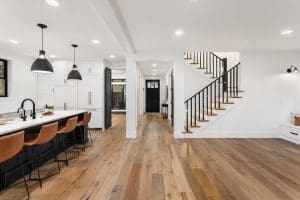Buying a home that requires renovation can be exciting, but financing both the purchase and renovation costs can feel overwhelming. Many prospective homeowners ask, “Can I add renovation expenses to my conventional mortgage?” Fortunately, the answer is yes, certain home renovation loan programs allow borrowers to bundle renovation costs with their mortgage, making it easier to turn a fixer-upper into a dream home. This article explores how to integrate renovation expenses into a conventional mortgage, the pros and cons of doing so, and key loan programs to consider. The RefiGuide will assist you in your quest to shop for the best home renovation loans from bank and lenders you can trust.
How to Add Renovation Costs to a Conventional Mortgage
These traditional loans are typically offered by private lenders and sold to Fannie Mae or Freddie Mac, two government-sponsored enterprises that help ensure liquidity in the housing market.
Since conventional loans are so popular and highly regarded, its natural for a borrower to want to finance home renovation costs into their mortgage.
Think of a conventional loan as a blank canvas—what you add to it depends on the financial tools available to you, including the option to incorporate renovation costs.
The most straightforward way to include renovation expenses in a conventional mortgage is through special loan programs that allow you to borrow extra funds for home improvements. These home renovation mortgage programs enable borrowers to buy a home and finance necessary upgrades with a single loan, saving time and simplifying the repayment process.
Why juggle multiple loans when you can combine your renovation and mortgage costs into one seamless package?
What is a Home Renovation Mortgage Loan?
A home renovation mortgage is a unique loan product that combines the cost of home buying with the expenses for renovations and repairs into a single mortgage. Borrowers repay the home renovation loan through monthly mortgage payments. The primary distinction between a traditional mortgage and a home renovation mortgage resides in the disbursement process—the renovation work must be completed within six months to one year after closing, even though the loan is repaid over a term of 15 to 30 years.
3 Popular Home Renovation Loan Options:
Fannie Mae HomeStyle® Renovation Loan:
This loan allows borrowers to finance both the purchase price and renovation costs with a single conventional mortgage. It covers cosmetic and structural repairs, offering flexibility to homeowners. This is a worthy construction loan for home renovation if you have good credit and wise counsel.
Freddie Mac CHOICERenovation® Loan:
Similar to the HomeStyle loan, this program helps buyers or current homeowners finance renovation projects as part of their mortgage. Both renovation mortgages require the borrower to submit a detailed renovation plan, including contractor estimates and timelines, for lender approval. This is another recommended option with an competitive home loan for renovation if you have the borrowing credentials and the right lender.
Home Equity Loan to Renovate:
Many homeowners buy a home and shortly thereafter they want to remodel or renovate their home. In many instances, the borrower is happy with their existing mortgage because they have a lower interest rate currently then what is available with a conventional refinance or construction loan. If this is the situation, you find yourself in, we recommend the home equity loan to renovate. Many of the best home equity loan lenders specialize in renovation mortgages and HELOCs that are worthy of considering. Whether you want a a fixed home equity renovation loan or a variable rate HELOC to finance construction, the RefiGuide has you covered. We will help you find a second mortgage for making home improvements.
Loan Requirements for Home Renovation Mortgages
Before you are ready shop home construction lenders, you need to understand what kind of borrowing credentials you need to get a approved for a construction loan for renovation.
You need to get your personal documentation organized and ready for the lenders underwriter to review.
To qualify for a mortgage that includes renovation costs, borrowers must meet specific criteria:
Credit Score: A minimum credit score of 620 is typically required for these loans.
Debt-to-Income Ratio: Lenders prefer a DTI ratio of 43% or lower.
Appraisal: The property’s future value (after renovations) will be considered in the appraisal process.
Down Payment: Most lenders require at least a 5% down payment based on the total loan amount (including renovation costs).
Wouldn’t it be easier to manage a single loan payment rather than tracking multiple loans for your home improvement projects?
The Pros and Cons of Bundling Renovation Costs with Your Mortgage
Pros:
Simplified Financing: One loan covers both the purchase and renovation, streamlining the process.
Lower Interest Rates: Conventional loan rates are typically lower than personal loans or credit cards used for renovations.
Higher Home Values: Renovations can boost the property’s market value, increasing equity.
Flexible Use of Funds: These home renovation loans cover a wide range of repairs, from minor upgrades to major structural improvements.
Adding renovation costs to your mortgage is like putting all your financial eggs in one basket—it simplifies your finances while ensuring you have everything you need in one place.
Cons:
Higher Loan Amount: Bundling renovation costs increases your loan amount, which may raise monthly payments.
Complex Application Process: These loans require detailed renovation plans and contractor bids, which can be time-consuming.
Appraisal Risks: If the property’s appraised value after renovation doesn’t meet expectations, your loan may be denied or reduced.
4 Steps to Secure a Home Mortgage and Renovation Loan
Step 1: Get Pre-Approved for a Home Renovation Mortgage
Start by getting pre-approved for a renovation mortgage to understand how much you can borrow. This step will also help you determine if you meet the credit score and DTI requirements for a competitive renovation mortgage loan.
Step 2: Create a Home Renovation Plan
Work with a licensed contractor to develop a detailed renovation plan, including cost estimates and timelines. This plan will be submitted to the lender for approval.
Step 3: Apply for Home Renovation Loans
Submit your loan application along with the renovation plan and contractor bids. The lenders will also arrange for a home appraisal to determine the property’s value after renovation.
Step 4: Close on the Home Renovation Loan
Once approved, you’ll close on the home loan and the funds for renovations will be disbursed in stages as the work progresses.
Isn’t it worth a little extra effort upfront to secure a loan that covers everything you need?
Alternatives to Renovation Mortgages
If you don’t qualify for a renovation mortgage or prefer a different option, consider these alternatives:
Home Equity Line of Credit: For homeowners with existing equity, a HELOC provides a revolving line of credit for renovations.
Cash-Out Refinance: Refinance your current mortgage and use the extra cash to fund renovations. Consider a cash out refinance if your existing mortgage rate is higher than current advertised interest rates.
Unsecured Personal Loan: Although personal loans have higher interest rates, they offer a quicker approval process.
FAQ on Home Renovation Loans
What is a Conventional Mortgage?
Conventional loans often come with lower interest rates and more flexible terms for borrowers with strong credit and financial stability. The Consumer Finance Protection Bureau defines a conventional loan as any mortgage that is not insured or guaranteed by a government agency, such as those offered through the Federal Housing Administration (FHA), Department of Veterans Affairs (VA), or Department of Agriculture (USDA) loan programs.
Can I get a construction loan for home renovation?
Yes, a construction loan can be used to finance home renovation and house remodeling. These home renovation mortgages are specifically designed to cover the costs of building a new home or making major renovations to an existing one, enabling you to borrow based on the projected value of your property after the renovations are finished. Getting a construction loan for home renovation is not something that should be taken lightly. Make sure you shop with multiple mortgage lenders that have experience with construction loans for home renovation.
Can I get a HELOC to finance home renovations?
The HELOC line of credit is a very popular choice for homeowners that need quick cash and they do not want to deal with the complex process of a conventional home construction loan. Since a HELOC is a second mortgage, the borrower can leave their primary mortgage in tact and get access to funds to finance home rehabilitation through a flexible home equity line of credit. Compare the HELOC vs construction loan when you talk to lending experts.
What are the closing costs with home renovation financing?
Closing costs for a home renovation loan is very similar to cash out refinancing and home equity loans. Most renovation lenders charge between 2% and 5% of the total amount borrowed. These closing costs and lending fees typically include appraisal fees, loan origination fees, title searches, underwriting, processing, and title insurance, similar to those associated with a traditional home loan. However, the exact amount may vary based on your lender and the specific terms of the home rehab loan.
Takeaway on Financing Home Renovation with Conventional Mortgage Loans
Adding renovation costs to a conventional loan is a smart way to finance a fixer-upper or upgrade an existing home. Home improvement programs like the Fannie Mae HomeStyle® and Freddie Mac CHOICERenovation® loans allow borrowers to streamline their finances by bundling the purchase and renovation expenses into a single loan. With careful planning and attention to the lender’s requirements, homeowners can enjoy the benefits of a renovated property while managing just one loan.
Why wait to enjoy the home of your dreams when you can bundle everything into one loan today? By understanding the process, weighing the pros and cons, and exploring alternatives, homeowners can make an informed decision that aligns with their financial goals.
The RefiGuide matches you with proven lenders for home equity loan to renovate who offer the best home renovation loans that meet your needs and eligibility. Our team will help you find the right construction loan for home renovation.


